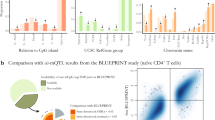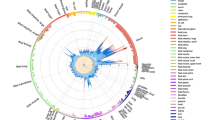Abstract
In a recent genome-wide association study (GWAS) based on 12 374 non-synonymous single nucleotide polymorphisms we identified a number of candidate multiple sclerosis susceptibility genes. Here, we describe the extended analysis of 17 of these loci undertaken using an additional 4234 patients, 2983 controls and 2053 trio families. In the final analysis combining all available data, we found that evidence for association was substantially increased for one of the 17 loci, rs34536443 from the tyrosine kinase 2 (TYK2) gene (P=2.7 × 10−6, odds ratio=1.32 (1.17–1.47)). This single nucleotide polymorphism results in an amino acid substitution (proline to alanine) in the kinase domain of TYK2, which is predicted to influence the levels of phosphorylation and therefore activity of the protein and so is likely to have a functional role in multiple sclerosis.
Similar content being viewed by others
Log in or create a free account to read this content
Gain free access to this article, as well as selected content from this journal and more on nature.com
or
References
Compston A, Coles A : Multiple sclerosis. Lancet 2008; 372: 1502–1517.
Hogancamp WE, Rodriguez M, Weinshenker BG : The epidemiology of multiple sclerosis. Mayo Clin Proc 1997; 72: 871–878.
Ebers GC, Sadovnick AD, Risch NJ : A genetic basis for familial aggregation in multiple sclerosis. Canadian Collaborative Study Group. Nature 1995; 377: 150–151.
Ebers GC, Yee IM, Sadovnick AD, Duquette P : Conjugal multiple sclerosis: population-based prevalence and recurrence risks in offspring. Canadian Collaborative Study Group. Ann Neurol 2000; 48: 927–931.
Sadovnick AD, Ebers GC, Dyment DA, Risch NJ : Evidence for genetic basis of multiple sclerosis. The Canadian Collaborative Study Group. Lancet 1996; 347: 1728–1730.
Jersild C, Svejgaard A, Fog T : HL-A antigens and multiple sclerosis. Lancet 1972; 1: 1240–1241.
Compston A, Confavreux C, Lassmann H et al: McAlpine's Multiple Sclerosis. Churchill Livingstone: Edinburgh, 2005.
Sawcer S, Ban M, Maranian M et al: A high-density screen for linkage in multiple sclerosis. Am J Hum Genet 2005; 77: 454–467.
Yang Q, Khoury MJ, Friedman J, Little J, Flanders WD : How many genes underlie the occurrence of common complex diseases in the population? Int J Epidemiol 2005; 34: 1129–1137.
Lindsey JW : Familial recurrence rates and genetic models of multiple sclerosis. Am J Med Genet A 2005; 135: 53–58.
Gregory SG, Schmidt S, Seth P et al: Interleukin 7 receptor alpha chain (IL7R) shows allelic and functional association with multiple sclerosis. Nat Genet 2007; 39: 1083–1091.
Lundmark F, Duvefelt K, Iacobaeus E et al: Variation in interleukin 7 receptor alpha chain (IL7R) influences risk of multiple sclerosis. Nat Genet 2007; 39: 1108–1113.
International Multiple Sclerosis Genetics Consortium T: Risk alleles for multiple sclerosis identified by a genome wide study. N Engl J Med 2007; 357: 851–862.
The International Multiple Sclerosis Genetics Consortium: Refining genetic associations in multiple sclerosis. Lancet Neurol 2008; 7: 567–569.
Hafler JP, Maier LM, Cooper JD et al: CD226 Gly307Ser association with multiple autoimmune diseases. Genes Immun 2009; 10: 5–10.
Rubio JP, Stankovich J, Field J et al: Replication of KIAA0350, IL2RA, RPL5 and CD58 as multiple sclerosis susceptibility genes in Australians. Genes Immun 2008; 9: 624–630.
The International Multiple Sclerosis Genetics Consortium: The expanding genetic overlap between multiple sclerosis and type I diabetes. Genes Immun 2009; 10: 11–14.
Burton PR, Clayton DG, Cardon LR et al: Association scan of 14,500 non synonymous SNPs in four diseases identifies autoimmunity variants. Nat Genet 2007; 39: 1329–1337.
Poser CM, Paty DW, Scheinberg L et al: New diagnostic criteria for multiple sclerosis: guidelines for research protocols. Ann Neurol 1983; 13: 227–231.
McDonald WI, Compston A, Edan G et al: Recommended diagnostic criteria for multiple sclerosis: guidelines from the International Panel on the diagnosis of multiple sclerosis. Ann Neurol 2001; 50: 121–127.
Purcell S, Cherny SS, Sham PC : Genetic Power Calculator: design of linkage and association genetic mapping studies of complex traits. Bioinformatics 2003; 19: 149–150.
Wigginton JE, Abecasis GR : PEDSTATS: descriptive statistics, graphics and quality assessment for gene mapping data. Bioinformatics 2005; 21: 3445–3447.
O'Connell JR, Weeks DE : PedCheck: a program for identification of genotype incompatibilities in linkage analysis. Am J Hum Genet 1998; 63: 259–266.
Dudbridge F : Pedigree disequilibrium tests for multilocus haplotypes. Genet Epidemiol 2003; 25: 115–121.
Minegishi Y, Saito M, Morio T et al: Human tyrosine kinase 2 deficiency reveals its requisite roles in multiple cytokine signals involved in innate and acquired immunity. Immunity 2006; 25: 745–755.
Tokumasa N, Suto A, Kagami S et al: Expression of Tyk2 in dendritic cells is required for IL-12, IL-23, and IFN-gamma production and the induction of Th1 cell differentiation. Blood 2007; 110: 553–560.
Watford WT, O'Shea JJ : Human tyk2 kinase deficiency: another primary immunodeficiency syndrome. Immunity 2006; 25: 695–697.
Graham DS, Akil M, Vyse TJ : Association of polymorphisms across the tyrosine kinase gene, TYK2 in UK SLE families. Rheumatology (Oxford) 2007; 46: 927–930.
Sigurdsson S, Nordmark G, Goring HH et al: Polymorphisms in the tyrosine kinase 2 and interferon regulatory factor 5 genes are associated with systemic lupus erythematosus. Am J Hum Genet 2005; 76: 528–537.
Shaw MH, Boyartchuk V, Wong S et al: A natural mutation in the Tyk2 pseudokinase domain underlies altered susceptibility of B10.Q/J mice to infection and autoimmunity. Proc Natl Acad Sci USA 2003; 100: 11594–11599.
Satoh JI, Obayashi S, Misawa T et al: Neuromyelitis optica/Devic's disease: gene expression profiling of brain lesions. Neuropathology 2008; 28: 561–576.
Phan UT, Arunachalam B, Cresswell P : Gamma-interferon-inducible lysosomal thiol reductase (GILT). Maturation, activity, and mechanism of action. J Biol Chem 2000; 275: 25907–25914.
Barjaktarevic I, Rahman A, Radoja S et al: Inhibitory role of IFN-gamma-inducible lysosomal thiol reductase in T cell activation. J Immunol 2006; 177: 4369–4375.
Hohol MJ, Orav EJ, Weiner HL : Disease steps in multiple sclerosis: a longitudinal study comparing disease steps and EDSS to evaluate disease progression. Mult Scler 1999; 5: 349–354.
Acknowledgements
We thank members of the Association of British Neurologists for notifying families. We acknowledge contributions from the International Multiple Sclerosis Genetics Consortium. This work was supported by the Medical Research Council (G0700061) and the National Institute of Health (NS 049477-01A1). We acknowledge use of DNA from the British 1958 Birth Cohort collection, funded by the Medical Research Council grant G0000934 and the Wellcome Trust grant 068545/Z/02. The Norwegian Bone Marrow Donor Registry is acknowledged for collaboration in the establishment of the Norwegian control material. AG is a Postdoctoral Fellow, EB a Research Assistant, and BD a Clinical Investigator of the Research Foundation Flanders (FWO-Vlaanderen). ARL and HFH are supported by The Research Council of Norway (166005/V5), the Ullevål University Hospital Scientific Advisory Council and by the Odd Fellow MS society. This study makes use of data generated by The Wellcome Trust Case–Control Consortium. A full list of the investigators who contributed to the generation of the data is available from www.wtccc.org.uk. Funding for the project was provided by The Wellcome Trust under award 076113 and reported in Nature 2007; 447; 661–78.
Author information
Authors and Affiliations
Consortia
Corresponding author
Additional information
Websites
StatsDirect statistical software – http://www.statsdirect.com.
PolyPhen – http://genetics.bwh.harvard.edu/pph/.
SIFT – http://blocks.fhcrc.org/sift/SIFT.html.
Supplementary information accompanies the paper on European Journal of Human Genetics website (http://www.nature.com/ejhg)
Rights and permissions
About this article
Cite this article
Ban, M., Goris, A., Lorentzen, Å. et al. Replication analysis identifies TYK2 as a multiple sclerosis susceptibility factor. Eur J Hum Genet 17, 1309–1313 (2009). https://doi.org/10.1038/ejhg.2009.41
Received:
Revised:
Accepted:
Published:
Issue date:
DOI: https://doi.org/10.1038/ejhg.2009.41
Keywords
This article is cited by
-
Neuroinflammation — using big data to inform clinical practice
Nature Reviews Neurology (2016)
-
Multiple sclerosis: getting personal with induced pluripotent stem cells
Cell Death & Disease (2015)
-
The European Genome-phenome Archive of human data consented for biomedical research
Nature Genetics (2015)
-
The Th17 axis in psoriatic disease: pathogenetic and therapeutic implications
Autoimmunity Highlights (2014)
-
The Emerging Role of IL-17 in the Pathogenesis of Psoriasis: Preclinical and Clinical Findings
Journal of Investigative Dermatology (2013)



